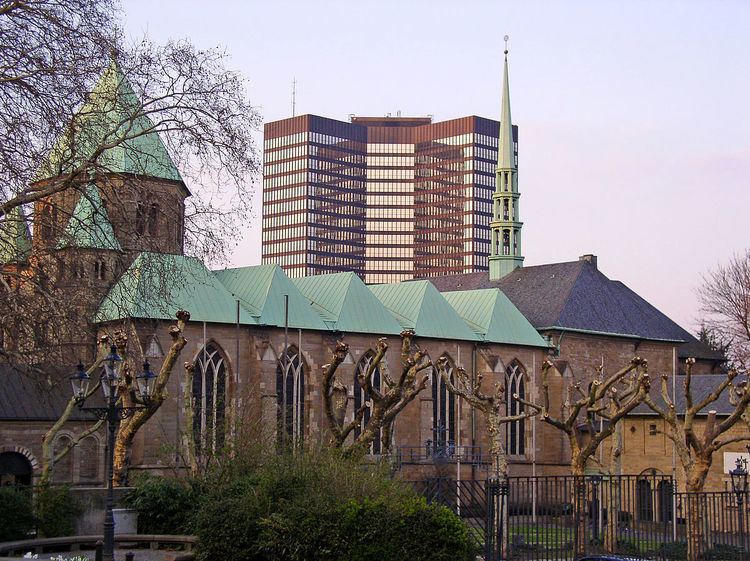Government Theocracy Founded circa 845 Date dissolved 1803 | ||
 | ||
Annexed by Prussia 1803–06/7 and from 1813 1803 | ||
Essen Abbey (Stift Essen) was a monastery of secular canonesses for women of high nobility in Essen, Germany. It was founded about 845 by the Saxon Altfrid (died 874), later Bishop of Hildesheim and saint, near a royal estate called Astnidhi, which later gave its name to the religious house and to the town. The first abbess was Altfrid's kinswoman, Gerswit.
Contents
Apart from the abbess, the canonesses did not take vows of perpetual celibacy, and were able to leave the abbey to marry; they lived in some comfort in their own houses, wearing secular clothing except when performing clerical roles such as singing the Divine Office. A chapter of male priests were also attached to the abbey, under a dean. In the medieval period, the abbess exercised the functions of a bishop, except for the sacramental ones, and those of a ruler, over the very extensive estates of the abbey, and had no clerical superior except the pope.
History
Because of its advancement by the Liudolfings (the family of the Ottonian Emperors) the abbey became reichsunmittelbar (an Imperial abbey) sometime between 874 and 947. Its best years began in 973 under the Abbess Mathilde, granddaughter of Otto I and thus herself a Liudolfing, who governed the abbey until 1011. In her time the most important of the art treasures of what is now the Essen Cathedral treasury came to Essen. The next two abbesses to succeed her were also from the Liudolfing family and were thus able further to increase the wealth and power of the foundation. In 1228 the abbesses were designated "Princesses" for the first time. From 1300 they took up residence in Schloss Borbeck, where they spent increasing amounts of time.
The abbey's territorial lordship, to which belonged the town of Essen that was centered on the monastery, grew up between the Emscher and the Ruhr, The town's efforts to become an independent Imperial city were frustrated by the abbey in 1399 and again, conclusively, in 1670. In the north of the territory was located the abbey's monastery of Stoppenberg, founded in 1073; to the south was the collegiate foundation of Rellinghausen. Also among the possessions of the abbey was the area round Huckarde, on the borders of the County of Dortmund and separated from the territory of Essen by the County of the Mark. Approximately 3,000 farms in the area owed dues to the abbey, in Vest Recklinghausen, on the Hellweg and round Breisig and Godesberg. From 1512 to its dissolution the Imperial abbey belonged to the Lower Rhenish-Westphalian Circle.
The abbey's Vögte were, in sequence:
In 1495 the abbey signed a contract with the Dukes of Cleves and Mark regarding the inheritance of the Vogtei, whereby it lost some of its political independence in that it was no longer able to choose its own Vogt.
From 1802 the territory was occupied by Prussian troops. The abbey was dissolved in 1803. The spiritual territory of three square miles passed to Prussia, then between 1806/1807 to 1813 to the Duchy of Berg and afterwards to Prussia again. The last abbess, Maria Kunigunde von Sachsen, died on 8 April 1826 in Dresden.
When in 1958 the Roman Catholic Diocese of Essen was created, the former abbey church became Essen Cathedral, to which the abbey's treasury (Essener Domschatz), including the famous Golden Madonna of Essen, also passed.
List of the Abbesses, later Princess-Abbesses, of Essen
The dates of the rule of the abbesses are incompletely preserved. The sequence of the abbesses between Gerswid II and Ida is uncertain, particularly in regard to the Abbess Agana.
